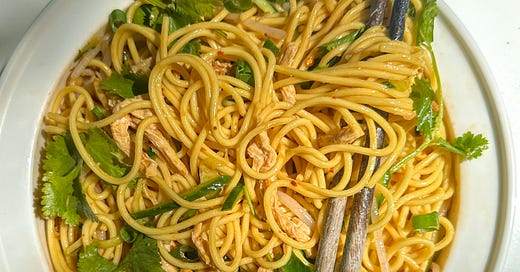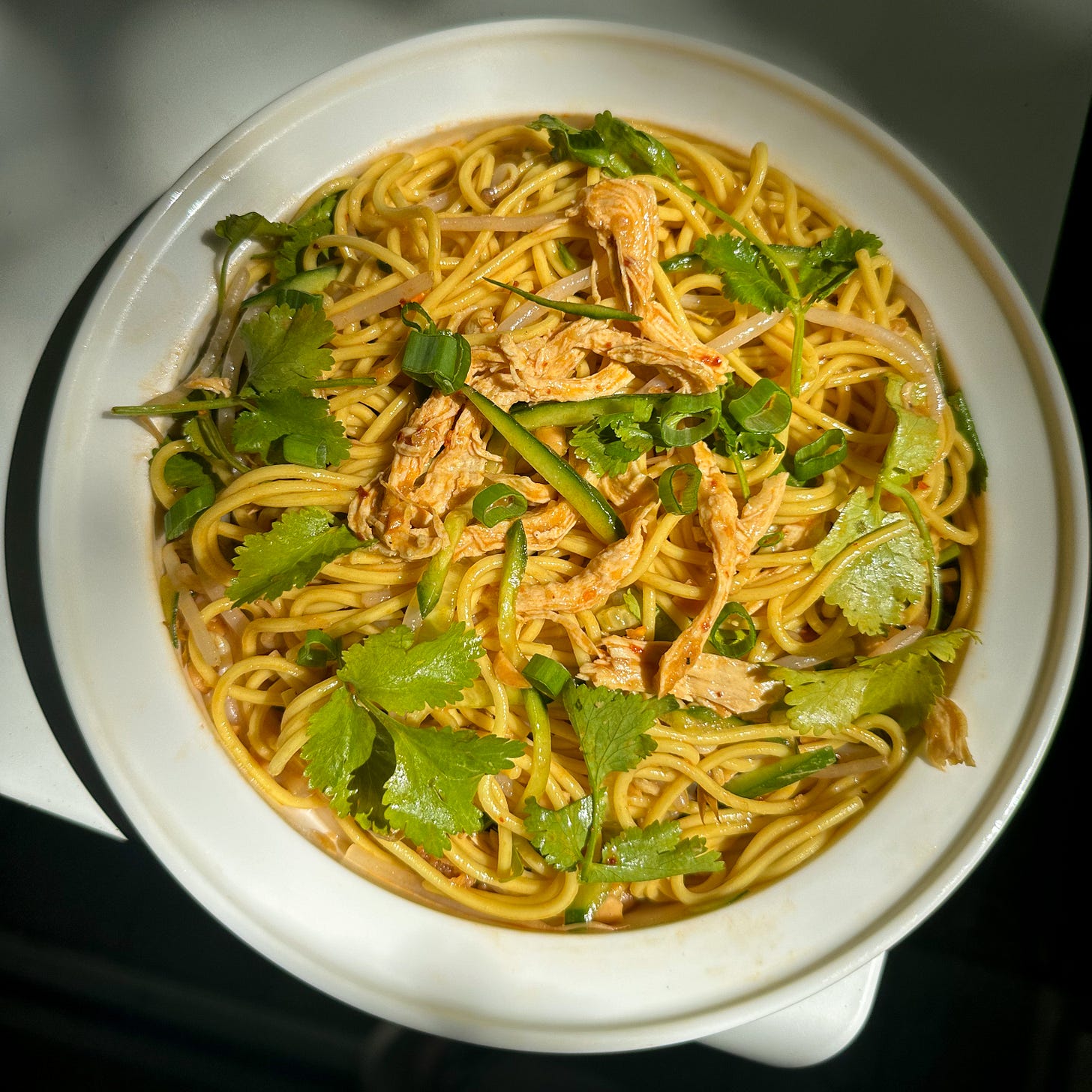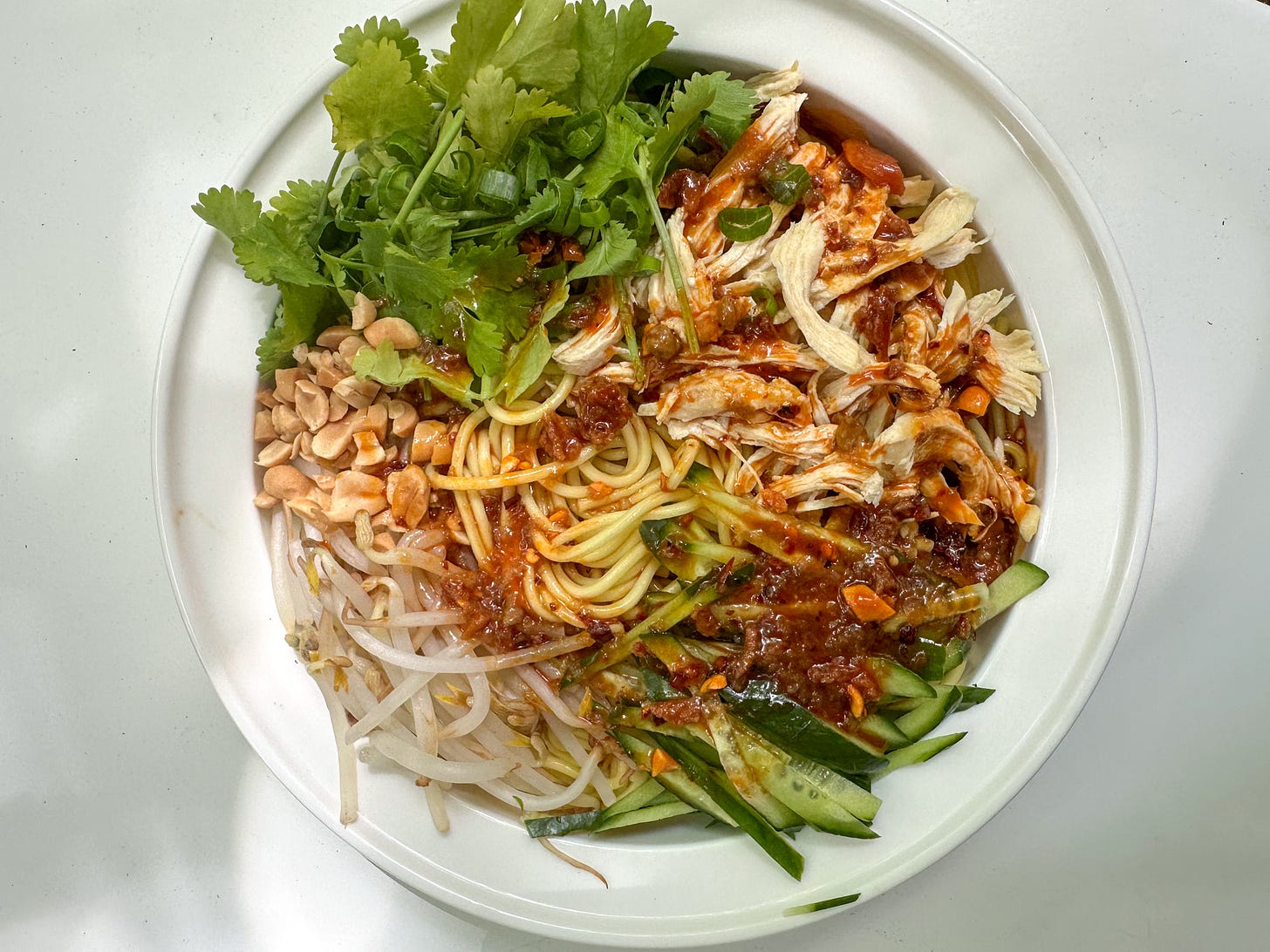Every year, early June (around the 7th-9th), is the big Gaokao exam (college entrance exam) in China. So I thought I’d share this story along with a cold noodle recipe.
Spending most of my school years in a boarding school, I only had big chunks of time to spend with my family during winter and summer breaks. Winter was mostly reserved for all the Chinese New Year food. For summer, which was usually unbearably hot and humid, two things frequented our dinner table the most: liangmian (凉面, cold noodles) and lukewarm xifan (稀饭, congee). Waipo, my maternal grandmother, was an expert at making liangmian. She always prepared a big batch of cold noodles on a giant enamel platter and cooled them down with a fan. When I arrived home sweaty and hungry, she would top them with shredded chicken, mung bean sprouts, and a flavorful chili oil sauce (for the child me, it was always milder). These noodles were devoured instantly.
One of my profound memories of liangmian is, however, not so happy. It was an afternoon in late June about 13 years ago. I got my Gaokao (Chinese college entrance exam) results right before I was heading to my grandparents' for dinner—liangmian as per usual. I didn’t do well, not well enough to get into the top-tier Chinese universities. I couldn’t recall what we talked about; we mostly just sat there, eating the noodles silently in the humid, despair-filled air. If you know about the Chinese education system, this is one of the toughest exams, and students study for years, almost brutally hard, for it. During my school time, it meant studying more than 12 hours a day, six days a week, for almost five years leading up to the exam. For many, Gaokao is the ultimate goal, the life-changing event for the first 18 years of their lives. For some, it’s traumatizing—my mom told me she still dreamt about her Gaokao at least once a year for the last 35 years.
Life moved on and took me far beyond that number. I was admitted to a relatively good college, majored in something I was passionate about, and later had the opportunity to study in Germany. I brought my waipo’s recipe to Berlin, sharing it at summer potlucks. During a recent WeChat call, she told me she didn't remember that day, and our conversation gradually shifted from how to cool the noodles to when I planned to get married. Classic Chinese grandma.
So here’s my interpretation of her recipe. You can tweak it as you like; for example, make it vegetarian (see tips below). When I struggle with the occasional heat here in Germany without an air conditioner, I find comfort in these cold noodles for a quick, appetizing meal.
The recipe
Servings: 2
Ingredients
200 g dried wheat noodles (alkaline noodles)
For the chicken:
1 chicken breast (150 g)
2 slices of ginger
1 scallion (white part)
For the sauce:
2 tsp sesame oil
2 tsp sesame paste
2 tbsp garlic water (1 clove of grated garlic + 2 tbsp water)
2 tbsp chili oil
2 tbsp light soy sauce
1 tbsp Chinese black vinegar
1 tbsp sugar
1 tsp Sichuan peppercorn oil (or a pinch of Sichuan peppercorn powder)
MSG or chicken powder (optional)
For assembly:
50 g bean sprouts
2 mini cucumbers, sliced into thin strips
scallion greens, thinly sliced
cilantro, roughly chopped
roasted, salted peanuts
Instructions:
Bring a pot of water to a boil. Add sliced ginger and scallion, then add the chicken breast. Cook for about 10 minutes. Turn off the heat and soak in the hot water for another 5 minutes. Once the chicken is cooked, add it to a bowl of ice water. Then shred the chicken with a fork or your hands into thin shreds. Set aside.
To make the sauce: Mix sesame paste and oil until smooth, then add garlic water, chili oil, light soy sauce, black vinegar, sugar, Sichuan peppercorn oil, and MSG if using. Mix until well combined.
Bring another pot of water to a boil. Add noodles and cook according to package instructions. Add to a colander and rinse with cold or ice water, then drain completely. In the same pot, blanch the bean sprouts for about 1 minute, then drain.
On a big plate or in a mixing bowl, add noodles, shredded chicken, bean sprouts, cucumber, scallion greens, cilantro, and roasted peanuts. Drizzle with the chili sauce and mix until combined.
How to make the best cold noodles
Choice of noodles
After many attempts, I found that the perfect noodles are dried alkaline noodles. In Asian grocery stores, they’re labeled as Wenzhou Miangan (温州面干) or Jianshui Noodles (碱水面). The second best choice is refrigerated fresh noodles. Otherwise, opt for chewier noodles. YouTube magical ingredients also recommend thin pasta like capellini.
How to cool the noodles
Traditionally, the noodles are drained and cooled with a fan or with air. This method, recommended by my grandma, works best if you have a big platter (or baking dish) and an electric or big woven fan.
Rinsing with cold or ice water is a shortcut that works for most home cooks. However, make sure you shake off excess water so the noodles are not soggy. I alternate between both methods. To prevent sticking, add sesame oil to the noodles.
Protein and vegetarian option
Store-bought rotisserie chicken, leftover roasted duck or turkey, or poached chicken thighs work great for this recipe.
To make it vegetarian, you can top it with eggs, seitan stripes or sliced five-spiced tofu.
Vegetables
Bean sprouts and cucumber are classic cold noodle toppings. Carrots, sliced lettuce, and even sliced apples (inspired by Korean cold noodle platters) are great too. If you have them, zhacai (pickled mustard plants) add a nice crunchy addition.
Sauce
My grandma’s recipe doesn’t include sesame paste, but it adds a bit of stickiness to the sauce, which I learned while making mouth-watering chicken.







Amazing for the warm summer days at the moment. So tasty!
I can’t wait to make this!